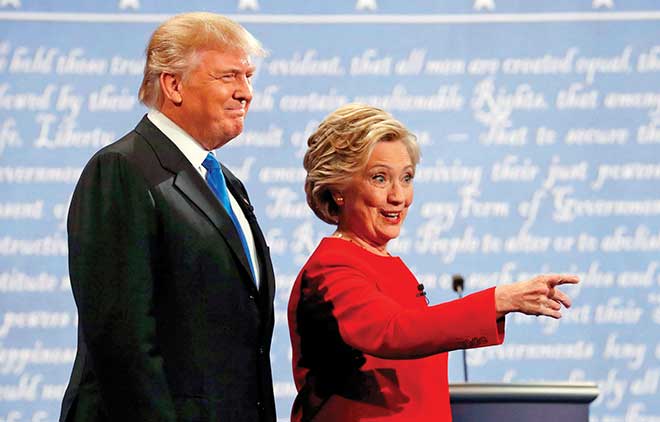university city
Stumpers for Trump and lovers of Hillary, get ready for a rematch. There should be plenty to love or hate this Sunday (Oct. 9), when the Democratic and Republican hopefuls square off for the second time, this go-round at Washington U., no stranger to presidential debates. Want tickets? Fuhgeddaboudit. Unless you’re a lucky Wash. U student, you’ll need to watch it on TV with the other 99,999,999 viewers expected to tune in (that number has been variably estimated at 100 million, minus you). All tickets to the debate were assigned by the Commission on Presidential Debates (CPD). Any tickets assigned to Wash. U were distributed only to full-time students selected in a university-wide lottery. This is the sixth time CPD has selected the university since 1992, when Bill Clinton, then-governor of Arkansas, faced George H.W. Bush, the sitting president. (There was a third dude behind a podium—remember Ross Perot?) This debate will be held in the university’s athletics complex, but the adjacent 60,000-square-foot recreation center newly opened in August also has been made available to the CPD. Wash. U was among 16 sites that submitted applications to host a general election debate this year. The institution has been known to move heaven and earth to host a debate: The first time, candidates finally agreed on a schedule at the late hour of Oct. 2, 1992 … but at the time, there was no venue for the first debate, set for Oct. 11! And the CPD didn’t visit the site until Oct. 4, which left exactly one week to prepare. Suffice it to say, Wash. U knows what to do. Prep has evolved considerably in 24 years. Instead of installing 12,500 phone lines, mobile cell towers will be used. And in 1992, the university had to convert showers into darkrooms, with students racing film from the debate hall. No need for that anymore; it’s all digital now.
 bridgeton
bridgeton
Clarification: St. Louis-Lambert International Airport is the official new name for our airport, even though we reported in our last issue that a different title was near approval. But this is final—honest. Aldermen in the City of St. Louis gave the go-ahead, much to the relief of Albert Bond Lambert’s descendants, who were concerned that the name ‘Lambert’ would eventually be lost to history. Our airport’s name has merely flipped at the hyphen, such that St. Louis now comes before Lambert. And the hyphen should keep Lambert and St. Louis stuck together like glue, just as they have been for years when the airport’s official name was ‘Lambert-St. Louis.’ All’s well that ends well. And while we’re at it, let’s tip our leather flying helmets to Mr. Lambert, ‘the Dean of St. Louis Aviation,’ Olympic silver medalist and scion of the first distributor of Listerine mouthwash! (Lambert Pharmacal Co. was the first to market the antiseptic in 1914, and it was the first OTC mouthwash.)
st. louis
It’s like the Doubletree by Hilton at St. Louis Union Station never existed. Well, at least it’s not listed on Doubletree’s website anymore. But it is—voilà!—still a Hilton property, albeit a tonier one: Hilton Curio. A $40 million face-lift has merited a new, more fitting name: ‘St. Louis Union Station Hotel, Curio Collection by Hilton,’ the latest addition to “a global set of distinctive upscale and luxury hotels hand-picked for travelers seeking local discovery and authentic experiences.” That is directly from a press release, which in this case is not hyperbole. Union Station was in its day arguably the most ornate train station in the country, no question the busiest, especially during the second World War. It was built in 1894 and converted to a hotel in 1985, back when the Rouse Co. of Baltimore first converted the venerable station into a retail, dining and entertainment complex. And things just continue to get more grand, like the Grand Hall, a stunning lobby lounge area with 65-foot-high ornate vaulted ceilings here a dazzling 3-D light show is now projected nightly. Gilding the lily? Absolutely not. One had better catch one’s jaw, because otherwise it will drop to the floor. Thirty vignettes stretch the barrier of creativity, design, innovation and storytelling through high-def ‘projection mapping,’ the first of its kind in the country. The station looks pretty much the same by day, and visitors can still amaze themselves with the famous ‘whispering arch’ just inside the hall entrance from Market Street. By 2018 they’ll be able to marvel at the largest collection of sharks in the Midwest (real ones!) from a bridge just inches above the water, in the 75,000-square-foot St. Louis Aquarium. All thanks to our friends at property owner Lodging Hospitality Management; they’ve combined little bits of the zoo and Six Flags with a hefty dose of elegance.
clayton
Oh no! Will our college-age daughters still want to come home to visit now that The ScholarShop is closing?? Yes, you read that right: the venerable Scholarship Foundation is shuttering the resell-it shop it has operated for 57 years. A changing retail scene has resulted in decreased sales and increased expenses, making the operation less profitable. And by profitable, of course, we mean beneficial for helping the nonprofit raise money to loan, interest-free, to local college students. A recent renovation of the Clayton store (there is a second store in Webster, also closing) cost nearly $300,000—no chump change for a nonprofit! It’s hard to see how the closings can further The Foundation’s mission to “maximize assistance to area students,” but we wish it well, especially as its 100-year anniversary approaches in 2020. There will be very little celebrating among the hoardes of women (and men) who scoured the racks for high-end goodies at pennies on the dollar.
 chesterfield
chesterfield
‘Monarch’ trees are the senior citizens of our woody world, and the one out in Chesterfield Blue Valley (CBV) is a doozy. According to developers of the complex a stone’s throw from the Daniel Boone Bridge spanning the Missouri River, the pecan tree is about 124 years old and 70 feet high. Its trunk is 14 feet around, with limbs extending 60 feet in all directions! Nearby stand three younger specimens, lined up like ducklings following their mama. Pecan Tree Legacy Park, slated for completion later this month, will frame the trees for as long as pecan nuts make pecan trees. The space is a half acre that will be lushly landscaped, planted with more than 2,600 perennials and will feature a grassy area large enough for gatherings and a 5-foot-wide exposed aggregate walk. Three staircases will descend into the shallow basin area, with the monarch tree as its central focus. The 132-acre CBV development now includes a Gander Mtn. store and a Cavender’s, and will soon feature a sports hotel and athletic complex. A large, old farmhouse was once part of the last 5.3 acres that CBV needed to acquire in order to complete a contiguous development, but preserving the tree was essential to satisfying the City of Chesterfield’s ordinance protecting such monarch trees. I remember pecan trees from my grandfather’s North Carolina farm (40 acres but no mule) as smallish specimens that anyway produced enough nuts for ‘Gaga’ to make a few luscious pies. Lord knows how many pies this tree and its three ‘volunteers’ could make of a pecan season. It’s a shame the farmhouse wasn’t preserved, because it would have been a lovely focal point to the left as shoppers drive into the nearby outlet mall. Someone so inclined could have made quite a bed and breakfast in the building—maybe as a refuge for tuckered out shoppers?








